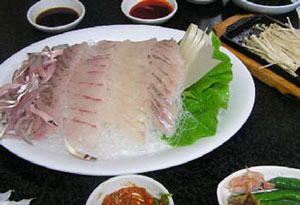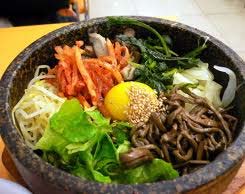
A gourmet heaven on earth, South Korea offers foods to tempt everyone’s taste buds. This Asian country’s English nickname is “The Land of the Morning Calm.”
It’s true that if you get up at 4 a.m., in the morning in Seoul, the country seems to live up to its name. The rest of the time though, Korea’s capital city is bustling with activity and people from all over the world: ESL teachers, project managers, sales executives, and army personnel from the United States and Britain, as well as factory workers from the Philippines, China, and Burma. Regardless of where they’re from, many fall in love with Korean food, just as I did when I went to work there in 1997 for the first time.
The pungent smell of garlic is everywhere — from the time you board the plane until the time you become accustomed to it sometime after landing in South Korea. A trip to a tiny market or big Korean grocery store turns up peeled garlic in small and large plastic bags. Garlic is a main ingredient in many Korean dishes, and by the time you leave Korea, you will also smell like garlic. Of course, garlic plays a part in Korea’s renowned dish, Kimchi.
The main ingredients in Kimchi are Napa or Chinese cabbage, red chili pepper paste or powder, garlic, water and salt. Every meal in Korea includes this spicy delicacy, rice, and soup. Restaurants serve Kimchi as a side dish, along with two to ten other dishes such as bean sprouts, seaweed salad, lotus roots, sweet potato slices, zucchini chunks, petite slices of cucumber and Danmuji, which is pickled Daikon radish.
Much of the influence in Korean food comes from China, where rice and the cabbage for Kimchi first grew. The chili pepper was native to South and Central America and came to Korea by way of merchant ships. Korea was a farming country until the 20th Century. Koreans dried many foods for use during the long, cold winters. Tradition dies hard, and even today, all over Korea in huge apartment complexes or near country homes, you will see the large stone containers for making Kimchi.
 Another staple is fish. Visit a Korean fish market to savor the smell of salty seawater and fish of all types; eels, herring, mullet, smelt, and puffer fish, and a popular snack with Koreans of all ages is dried minute and large pieces of fish. Eating raw fish in Korea is an occasion, not just a meal. At the fish markets, you can choose the fish you want, and the servers will prepare it and bring it to you with rice and Kimchi, lettuce, garlic, and red soybean paste. You pick up the fish with your chopsticks, place it in a lettuce leaf with the other ingredients, and wrap them all together. Munch away and enjoy, for this is truly one of the finer meals in Korea.
Another staple is fish. Visit a Korean fish market to savor the smell of salty seawater and fish of all types; eels, herring, mullet, smelt, and puffer fish, and a popular snack with Koreans of all ages is dried minute and large pieces of fish. Eating raw fish in Korea is an occasion, not just a meal. At the fish markets, you can choose the fish you want, and the servers will prepare it and bring it to you with rice and Kimchi, lettuce, garlic, and red soybean paste. You pick up the fish with your chopsticks, place it in a lettuce leaf with the other ingredients, and wrap them all together. Munch away and enjoy, for this is truly one of the finer meals in Korea.
If you’re a meat lover, you’ll adore Samguypsal, which is slices of pork belly that looks like bacon, although it’s served raw, you cook it on your personal grill at many restaurants. It comes with the same ingredients as the raw fish, and you wrap it up as well. The crispy pork is delicious and people eat it family style, which is the also case with all Korean side dishes.
There are many choices for the vegetarian or vegan in Korea. Tangy Asian pears, huge strawberries, baby watermelons, and semi-soft persimmons that you cut are just a few of the tantalizing fruits.
 Pibimpap is rice topped with a plethora of veggies including several types of mushroom, zucchini, carrots, bean sprouts, and lightly cooked spinach. If you want an egg on top for some extra protein, you should ask for Dolsot Pibimpap.
Pibimpap is rice topped with a plethora of veggies including several types of mushroom, zucchini, carrots, bean sprouts, and lightly cooked spinach. If you want an egg on top for some extra protein, you should ask for Dolsot Pibimpap.
Speaking of rice, Kimpap is the Korean form of sushi. The difference between Kimpap and sushi is that Kimpap doesn’t use raw fish as an ingredient. Another difference is that Kimpap rolls have seaweed on the outside and include Danmuji, cucumber, imitation crabmeat, and carrots. This simple dish takes time to prepare, as do all Korean foods.
The bottom line is that if you haven’t eaten Korean food, you just haven’t lived. Many of the recipes are very easy to make. Some require ingredients only available online or at international markets. All large cities in the United States have Korean restaurants, but these restaurants may have a fork if you ask. It’s best to brush up on your chopstick use ahead of time, and you’ll surely find something to fill your stomach and delight your taste buds.
Sources:
Kimchi ingredients: http://www.davidlebovitz.com/archives/2008/02/a_kimchi_recipe.html
History of Korean food: http://www.pbs.org/hiddenkorea/food.htm
